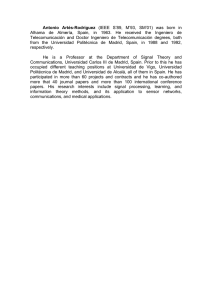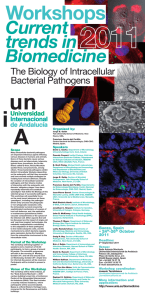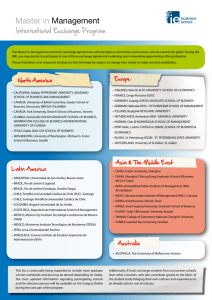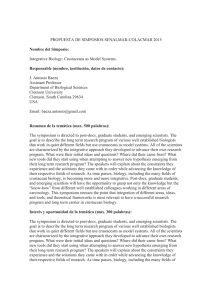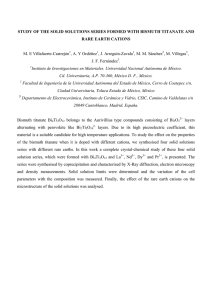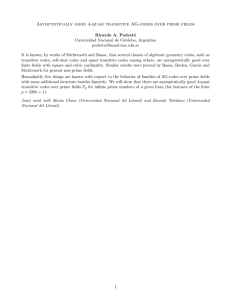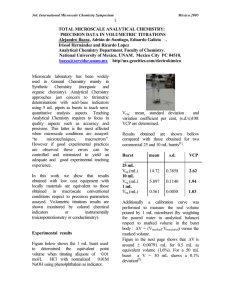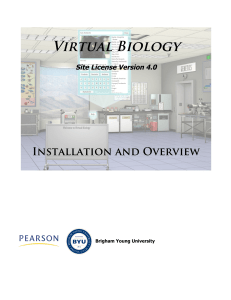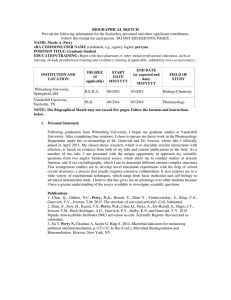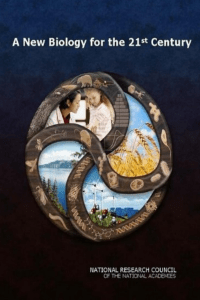chromati domai sadi sulators - CNB
Anuncio
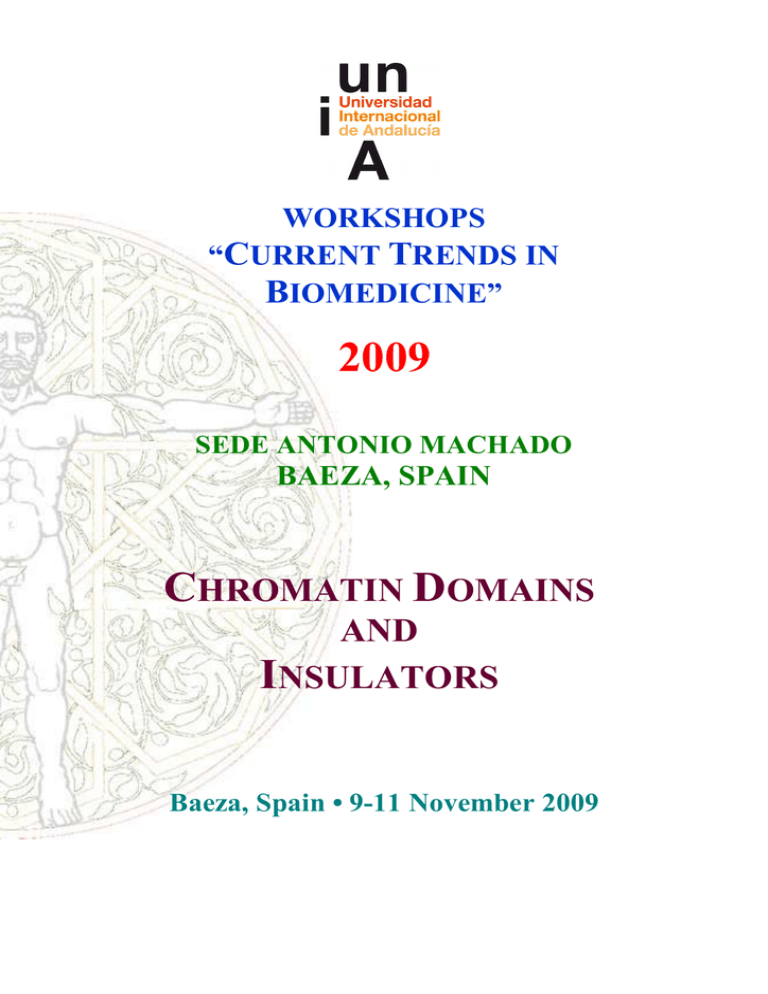
WORKSHOPS “CURRET TREDS I BIOMEDICIE” 2009 SEDE ATOIO MACHADO BAEZA, SPAI CHROMATI DOMAIS AD ISULATORS Baeza, Spain • 9-11 ovember 2009 Organized by: Víctor G. Corces Emory University. Atlanta, USA. Lluís Montoliu Centro Nacional de Biotecnología (CNB-CSIC). Madrid, Spain. Félix Recillas-Targa Universidad Nacional Autónoma de México. México DF, Mexico. SCOPE During the past years a number of genomes from different species, including various vertebrates and, among them, several mammalian species, have been completely sequenced. The use of powerful bioinformatics approaches has allowed the identification of evolutionary conserved sequences that spread well beyond the coding regions and, thus, include regulatory elements that appear to transduce relevant functional and/or structural constraints that have been preserved in different species, presumably originating in the genome of a common ancestor. Boundaries or insulators are a specific type of regulatory elements, first discovered in Drosophila and yeast and later shown to be present in vertebrate genomes. These elements are characterised as possessing at least one of the following two features: to act as blockers, thereby preventing the communication and interaction between distal enhancers and proximal promoters; or to act as barriers, thereby preventing the spreading of negative heterochromatic effects originating in the chromosome that could compromise the expression of neighbouring loci. To date, several types of boundary elements have been identified. They share a common function but appear to be unrelated at the structural level therefore suggesting that, throughout the evolution, the system has been using different mechanisms that have been adapted to suit the requirements of an insulator, that is: protecting a set of sequences from surrounding loci and thus allowing the internal regulatory elements to control the gene and avoiding other distal elements to alter the pattern of expression. This workshop on “chromatin domains and boundaries” will address and discuss the most updated knowledge of how chromatin is organised in the eukaryotic nucleus and what is the role of insulators in this process. Worldwide recognised and leading scientists in the field will discuss the different aspects in which this topic has been addressed in the recent literature. The workshop will cover from general descriptions of boundaries in vertebrate and invertebrate genomes, to more specific roles of boundaries in nuclear or cellular processes. FORMAT OF THE WORKSHOP The workshop will bring together 17 speakers and a maximum of 50 participants (including speakers). The scientific programme will start in the morning of Monday, November 9th, and will end around noon on Wednesday, November 11th. Ample time for informal discussion will be reserved. Participants will be invited to present a poster. VEUE OF THE WORKSHOP The workshop will be held in Baeza, at the “Sede Antonio Machado”, a XVII century building turned into a Conference Centre of the Universidad Internacional de Andalucía (UNIA). This Seat includes a recently restored residence, where participants will be accommodated. Baeza is a World Historic Heritage town, renowned for its Renaissance and Gothic buildings. SPEAKERS Giacomo Cavalli Chromatin and Cell Biology Lab, Institute of Human Genetics, CNRS. Montpellier, France. Víctor G. Corces Department of Biology, Atlanta, GA, USA. Ann Dean Laboratory of Cellular and Developmental Biology, National Institute of Diabetes and Digestive and Kidney Diseases, NIH. Bethesda, MD, USA. David W. Emery Division of Medical Genetics, Department of Medicine, University of Washington. Seattle, WA, USA. Ann J. Feeney Department of Immunology and Microbial Science, The Scripps Research Institute. La Jolla, CA, USA. Gary Felsenfeld Laboratory of Molecular Biology, National Institute of Diabetes and Digestive and Kidney Diseases, NIH. Bethesda, MD, USA. Pavel Georgiev Department of the Control of Genetic Processes, Institute of Gene Biology, Russian Academy of Sciences. Moscow, Russia. Emory University. José Luis Gómez-Skarmeta Centro Andaluz de Biología del Desarrollo (CABD), CSIC-Universidad Pablo de Olavide. Sevilla, Spain. Roderic Guigó Bioinformatics and Genomics Program, Centre de Regulació Genòmica, Universitat Pompeu Fabra. Barcelona, Spain. Rohinton T. Kamakaka Department of MCD Biology, Sinsheimer Labs, University of California, Santa Cruz. Santa Cruz, CA, USA. Elena Klenova Department of Biological Sciences, University of Essex. Essex, UK. Victoria V. Lunyak Buck Institute for Age Research. Novato, CA, USA. Marc A. Marti-Renom Structural Genomics Unit, Bioinformatics & Genomics Department, Centro de Investigación Príncipe Felipe (CIPF). Valencia, Spain. Lluís Montoliu Department of Molecular and Cellular Biology, Centro Nacional de Biotecnología (CNB-CSIC). Madrid, Spain. Rolf Ohlsson Department of Microbiology, Tumor and Cell Biology, Karolinska Institute. Stockholm, Sweden. Félix Recillas-Targa Instituto de Fisiología Celular, Departamento de Genética Molecular, Universidad Nacional Autónoma de México. México DF, Mexico. Bing Ren Ludwig Institute for Cancer Research, Department of Cellular and Molecular Medicine, University of California San Diego School of Medicine. La Jolla, CA, USA. DEADLIE: 11 SEPTEMBER 2009 WORKSHOP COORDIATOR: Joaquín Torreblanca (Universidad Internacional de Andalucía) E-mail: [email protected] MORE IFORMATIO AD APPLICATIO: http://www.unia.es/biomedicine Universidad Internacional de Andalucía Sede Antonio Machado Palacio de Jabalquinto Plaza de Santa Cruz, s/n. 23440 Baeza (Jaén), Spain Tel: +34 953 74 27 75. Fax: +34 953 74 29 75. E-mail: [email protected]

